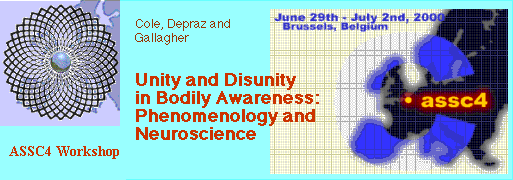
Home -
1 -
2 -
3 -
4 -
5 -
6 -
7 -
8 -
9 -
10 -
11 -
12 -
13 -
14- Bibliography
0. Workshop Description
In this workshop we explore how one's body, and especially motor behavior,
shapes conscious experience. To what extent, and in what precise way is
the body present in perceptual experience? Is it possible to have a
non-perceptual present awareness of one's body? To what extent does the
unity of perceptual consciousness depend on the phenomenological
transparency of the body? How does motoric behavior, much of which is not
conscious, affect conscious experience? What is the relationship between
consciousness and gestural movement? We address these issues from several
perspectives, including:
-
Phenomenology: A phenomenological approach allows us to consider issues
pertaining to body-image and to investigate the question of perceptual and
non-perceptual awareness.
-
Clinical Studies: We explore the contrasting characteristics of unilateral
neglect and deafferentation. We detail one particular rare case (IW)
involving loss of proprioception and touch from the neck down.
-
PET and magnetic stimulation studies: The results of PET studies of IW
involving self-movement and visual monitoring help to identify brain areas
responsible for movements under visual control and those made without
apparent feedback.
-
Experimental studies: Results of experiments we conducted on IW's ability
to gesture indicate to what extent gesture depends on proprioceptive
feedback, and suggest precise conclusions concerning the relationship
between motor and communicative aspects of gestural behavior.
Outline of workshop:
-
Phenomenological description of normal bodily experience. Awareness of
the body during intentional action. Perceptual and non-perceptual
awareness of the body. The status of proprioception. The distinction
between body image and body schema. Questions and Discussion.
-
Empirical evidence for the distinction between body image and body
schema. The case of unilateral neglect. Loss of body image. The case of
deafferentation: IW. The effects of a loss of proprioception and touch
from the neck down. Loss of body schema. Difficulties with motor control;
the visual and cognitive monitoring of movement. Questions and Discussion.
-
Results of magnetic stimulation studies of IW. Visual and imaginative
control as replacement for proprioceptive body schema. Task: small movement
of thumb; superimposed magnetic stimulation. Evidence against perception of
movement based on central corollary discharge. Questions and Discussion.
-
Results of PET scans of IW. The experiment involved a simple sequential
finger/thumb apposition task. Four conditions of movement were investigated:
(a) Self-movement and visual monitoring
(b) Self-movement without visual monitoring
(c) No self-movement and visual perception of other's movement
(d) No self-movement and no visual perception of movement
By comparison of the patterns of activation within the brain
for these conditions in IW and controls conclusions may be made about
the brain areas involved in movement without peripheral
feedback. The areas activated during visual control of movement and
during movement without visual or peripheral feedback may be analysed
and from this the roles of parietal cortex and cerebellum in corollary
discharge considered. Questions and Discussion.
-
Experiments on gesture. To what extent does gestural movement
depend on conscious monitoring? What does the motor system contribute to
language? Is it purely central or based on sensory feedback?
Experiments with deaf unilateral neglect patients (Bellugi and Klima
1997) and with IW show to what extent and in what way embodiment is a
necessary condition for linguistic behavior, and to what extent language
transcends embodiment and shapes our thought.
-
Conclusions: The phenomenology of neglect and deafferentation as
well as the experimental results allow us to draw conclusions about the
need for body awareness during various motor tasks. Work from PET
studies suggest the brain areas involved in movements under visual
control and those made without apparent feedback. We discuss the
implications of the empirical data for the question of the unity of
consciousness, and outline a distinction between the phenomenal unity
and the prenoetic unity of consciousness.
Home -
1 -
2 -
3 -
4 -
5 -
6 -
7 -
8 -
9 -
10 -
11 -
12 -
13 -
14- Bibliography

